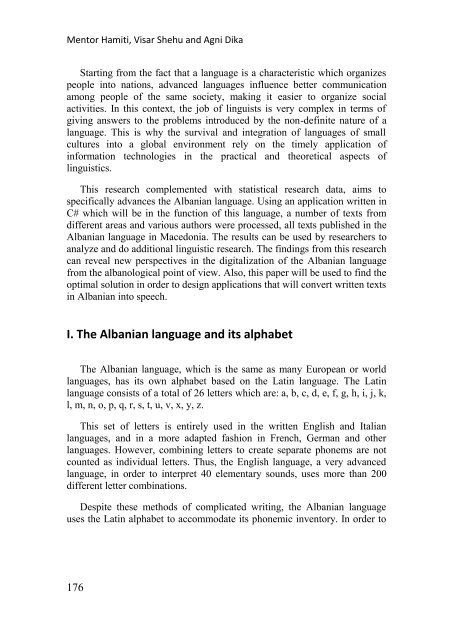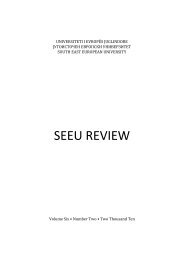SEEU Review vol. 5 Nr. 2 (pdf) - South East European University
SEEU Review vol. 5 Nr. 2 (pdf) - South East European University
SEEU Review vol. 5 Nr. 2 (pdf) - South East European University
You also want an ePaper? Increase the reach of your titles
YUMPU automatically turns print PDFs into web optimized ePapers that Google loves.
Mentor Hamiti, Visar Shehu and Agni Dika<br />
Starting from the fact that a language is a characteristic which organizes<br />
people into nations, advanced languages influence better communication<br />
among people of the same society, making it easier to organize social<br />
activities. In this context, the job of linguists is very complex in terms of<br />
giving answers to the problems introduced by the non-definite nature of a<br />
language. This is why the survival and integration of languages of small<br />
cultures into a global environment rely on the timely application of<br />
information technologies in the practical and theoretical aspects of<br />
linguistics.<br />
This research complemented with statistical research data, aims to<br />
specifically advances the Albanian language. Using an application written in<br />
C# which will be in the function of this language, a number of texts from<br />
different areas and various authors were processed, all texts published in the<br />
Albanian language in Macedonia. The results can be used by researchers to<br />
analyze and do additional linguistic research. The findings from this research<br />
can reveal new perspectives in the digitalization of the Albanian language<br />
from the albanological point of view. Also, this paper will be used to find the<br />
optimal solution in order to design applications that will convert written texts<br />
in Albanian into speech.<br />
I. The Albanian language and its alphabet<br />
The Albanian language, which is the same as many <strong>European</strong> or world<br />
languages, has its own alphabet based on the Latin language. The Latin<br />
language consists of a total of 26 letters which are: a, b, c, d, e, f, g, h, i, j, k,<br />
l, m, n, o, p, q, r, s, t, u, v, x, y, z.<br />
This set of letters is entirely used in the written English and Italian<br />
languages, and in a more adapted fashion in French, German and other<br />
languages. However, combining letters to create separate phonems are not<br />
counted as individual letters. Thus, the English language, a very advanced<br />
language, in order to interpret 40 elementary sounds, uses more than 200<br />
different letter combinations.<br />
Despite these methods of complicated writing, the Albanian language<br />
uses the Latin alphabet to accommodate its phonemic inventory. In order to<br />
176

















